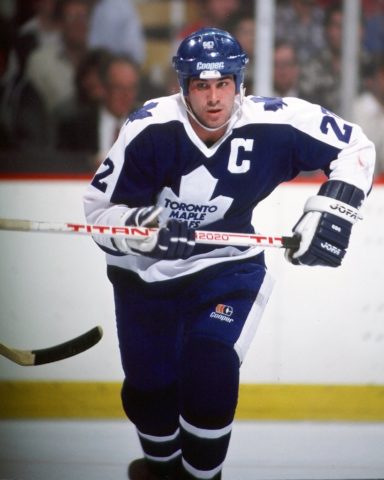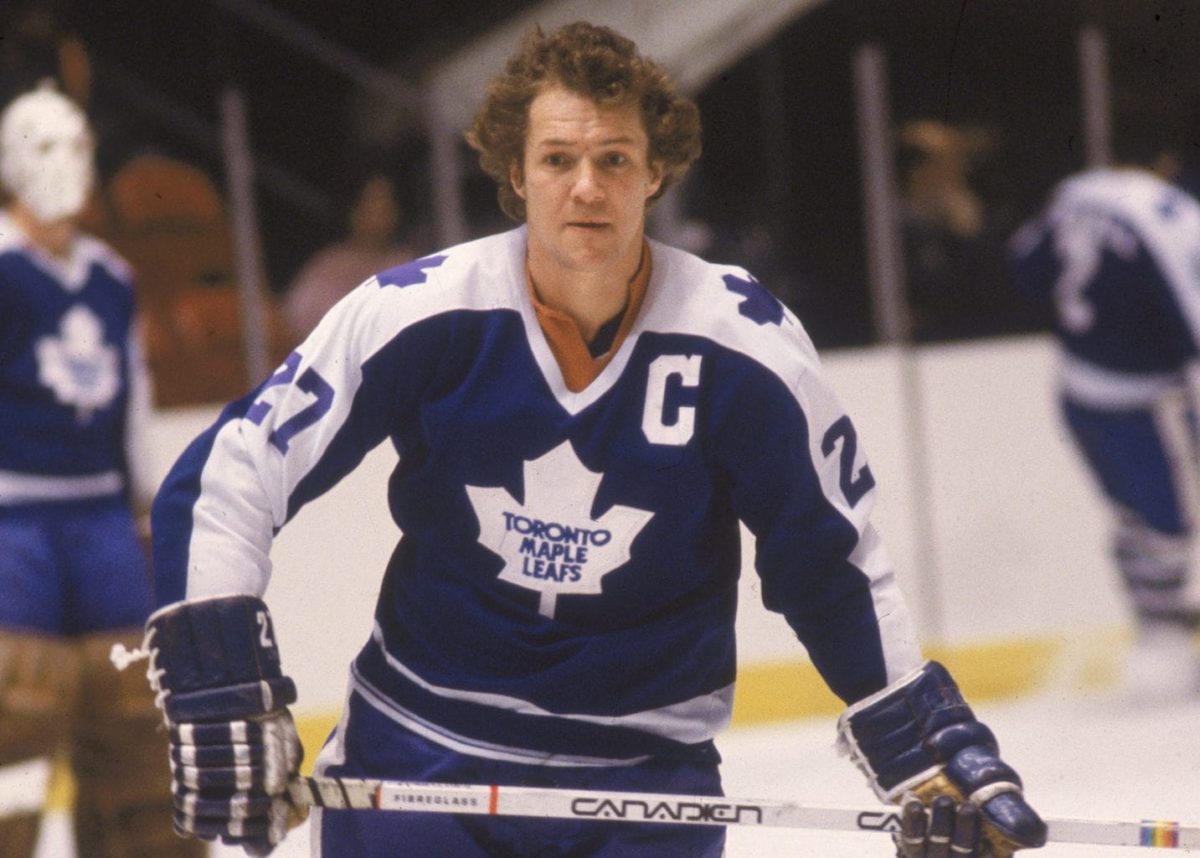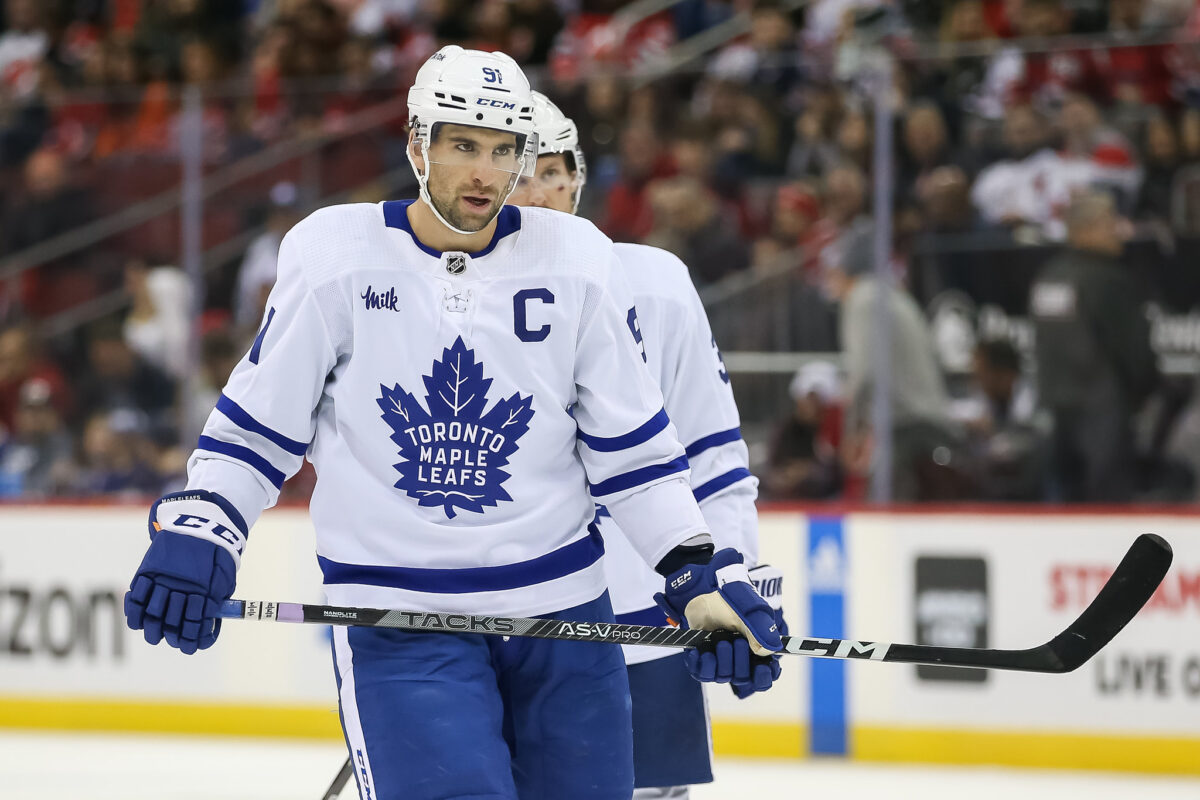Last week, Auston Matthews officially became the 26th captain in the history of the Toronto Maple Leafs franchise, assuming the ‘C’ from John Tavares as part of a long-planned transition. In becoming captain, Matthews now joins a celebrated group of some of the organization’s biggest icons who bore the privilege and responsibility of the captaincy.
If we were to look at the best of that decorated group, we’d likely have to go back a ways to those whose leadership brought Stanley Cup triumphs. “Chief” George Armstrong’s 11 seasons as captain produced four Cups, while legendary Maple Leafs like Syl Apps and Ted “Teeder” Kennedy also oversaw championship victories while donning the ‘C’.
But even while the post-Expansion era hasn’t yielded anything in the way of Cups (as Leafs fans are regularly reminded), the ‘C’ has adorned the jersey of many Toronto greats. In recognition of the torch being passed from Tavares to Matthews and, with it, the anointment of the franchise’s 10th captain since their last Cup, let’s rank the nine men to have been named captain since the Maple Leafs were last champions.
9. Rob Ramage
Amongst an esteemed group of Maple Leafs, many of whom with names and numbers hanging in the rafters of Scotiabank Arena, it’s a little jarring to see Rob Ramage included in the list of former captains. Although he was a 15-year NHL defenseman and a two-time Cup champion, most fans are most likely to remember him as the impaired driver at the wheel in the collision that killed former Chicago Blackhawk Keith Magnuson.
Ramage was traded to the Maple Leafs from the Calgary Flames following their Cup-winning 1988-89 season and was immediately named captain after the organization had gone two seasons without one. The club actually saw a 10-win improvement during his first season in Toronto on the strength of Gary Leeman’s 51-goal campaign, but quickly fell 4-1 to the St. Louis Blues in the division semifinals. By the following season, they had regressed back to fifth in the Norris Division with just 23 wins before Ramage was left to be claimed by the Minnesota North Stars in the confusing 1991 expansion draft.
8. Rick Vaive
Nowadays, Rick Vaive is an esteemed Maple Leafs alumnus and ambassador of the organization, fondly remembered as the club’s first 50-goal scorer. In fact, he hit the lofty 50-goal mark three seasons in a row. The fact that none of those seasons (1981-82, 1982-83 and 1983-84) reaped winning records can hardly be blamed on the Ottawa native.

However, just because Vaive knew how to score goals didn’t make him a great leader. It wasn’t until his fourth season as captain that the Maple Leafs managed to win a playoff series. By that time, though, the ‘C’ had already been unceremoniously removed from his jersey after he slept in and missed a team practice during the 1985-86 season after drinking heavily the night before.
7. Dion Phaneuf
A celebrated addition when acquired by then-general manager (GM) Brian Burke during the 2009-10 season, Dion Phaneuf eventually became a popular scapegoat for Maple Leafs fans when the early-2010’s teams that he led failed to live up to expectations. Over his six seasons as captain after being appointed in the summer following his trade to Toronto, the club managed just one playoff appearance that culminated in the infamous 4-1 blow lead against the Boston Bruins in Game 7 of the first-round series.
While Phaneuf has always been praised by his teammates, the big, physical defenseman seemed less comfortable in front of the media. He often came off as surly and standoffish, which didn’t help perceptions that Burke had handed him the captaincy to make his trade acquisition look better. The former Calgary Flame’s tenure as captain saw fans throw jerseys – and waffles – on the ice in protest of their performance. Partially in response to the fans’ show of disenchantment, Toronto sparked controversy by foregoing their traditional sticks-in-the-air salute at centre ice after home games.
6. Doug Gilmour
It’s been said that Doug Gilmour was a Maple Leafs superstar who just couldn’t get his timing quite right. After all, his 127-point, Selke Award-winning 1992-93 campaign might have been the best season in club history, but he lost the Hart Memorial Trophy thanks to Mario Lemieux’s 160-point season. That year, the team also fell short in their quest for the Cup in a seven-game series loss to Wayne Gretzky and the Los Angeles Kings. He might have even been considered the greatest Leaf of all-time had he lasted more than six seasons.
When it comes to Gilmour’s captaincy, the same holds true. When he was acquired from the Flames on January 2, 1992, Wendel Clark (more on him later) was still in his first season as captain. It wasn’t until Clark was traded in the summer of 1994 – after the iconic 127-point season – that Gilmour would don the ‘C’. By that point, extenuating circumstances like the NHL lockout, the addition of Mats Sundin, and the twilight of Gilmour’s prime contributed to decreased production amidst some forgettable seasons for the franchise. He ultimately oversaw three seasons as captain and no playoff series wins.
5. Darryl Sittler
It could be argued that Darryl Sittler had the toughest job of any of the organization’s captains. While most captains simply have rival teams to contend with, Sittler had to battle team management and owner Harold Ballard during his tenure. The Hall of Famer famously clashed with Ballard over the firing of head coach Roger Neilson and ripped the ‘C’ off of his jersey when GM Punch Imlach spitefully traded away Lanny McDonald.

While Sittler remains a revered figure in Leafs lore, both for his production in Toronto and his willingness to stand up against the hated Ballard. In some ways, the actions he took against his own bosses reflect exceptional character and moral conviction, hallmarks of a great leader. That may certainly be true, but it’s hard to put Sittler higher on this list when his time as captain was so heavily marred by a meddlesome owner and a toxic environment.
You Might Also Like
- One Burning Question for Every NHL Team in 2025
- Insider Believes Maple Leafs’ Top Trade Target This Season is a Defensive Center
- Bobby McMann: Maple Leafs’ Hidden Gem Fuels Depth Scoring
- Can Matt Murray Solve the Maple Leafs’ Goaltending Dilemma?
- 3 Bold Predictions for the Toronto Maple Leafs in 2025
4. Dave Keon
Much like Sittler, Dave Keon is one of the franchise’s most widely-respected and beloved legends, so it might seem surprising to see him ranked in the middle range. Unfortunately, by the time Keon assumed the ‘C’ from a believed-to-be-retiring Armstrong (he would return to the Leafs shortly after announcing his retirement), the club was two years removed from their 1967 Cup and in an abysmal state. In fact, over his six seasons as captain, Toronto won just one playoff round and missed the postseason twice.
Keon did everything he could for the Maple Leafs as captain, putting together three seasons with 30-plus goals and two years topping the 70-point mark while playing every night. But also in the same vein as Sittler, his tenure as captain was marred by a contentious relationship with Ballard, who publicly blasted the Leafs legend’s leadership. Instead of letting him go elsewhere, however, Ballard set a compensation price for his services so high that it effectively barred Keon from joining another NHL club and forced him to the World Hockey Association.
3. John Tavares
When it comes to looking back on Tavares’ captaincy, it’s all about perspective. On one hand, Toronto reached the postseason in each of his five years as team leader. When they finally broke through with a playoff series victory in 2022-23, it was Tavares who played overtime hero in Game 6 to send them through. All told, the 33-year-old has averaged roughly 30 goals and 70 points since joining his hometown Maple Leafs as a free agent while demonstrating high-quality leadership through some difficult seasons and a global pandemic.

Tavares’ legacy with the club is integrally associated with the ‘Core Four’, for better or worse. While his offensive production since joining the Maple Leafs (184 goals, 419 points in 440 games) has been nothing short of commendable, it can look a little underwhelming through the lens of his $11 million per season contract. That deal ends at the end of this season, which has already been a source of much speculation and discussion and may have helped expedite the transition to Matthews as captain.
2. Wendel Clark
It might surprise newer Maple Leafs fans to know that Clark, one of the most revered figures in the history of the franchise, only led the team as captain for three seasons. It wasn’t long after he assumed the ‘C’ from Ramage that he was dealt away in a blockbuster trade for the No. 1 player on this list. Still, it is a testament to the one-time first overall pick’s character and dedication to the organization that he remains regarded as such a strong leader – both for his captaincy between 1991 and 1994 and his seven total seasons (over two separate stints in Toronto) spent as an alternate captain.
Clark’s brief tenure as captain began with a season out of the playoff picture, but quickly improved to back-to-back conference final seasons, arguably the post-1967 high point for the franchise. Over that time, the bruising forward known as “Captain Crunch” made his mark as both a locker room leader and an on-ice star who ranked among the club’s top scorers and was regarded by opposing teams for his ferocious, punishing play style. This culminated in a 1993-94 season that saw him score a career-best 46 goals while also racking up 115 penalty minutes.
1. Mats Sundin
It’s not easy following in the footsteps of Clark and then Gilmour, but that’s exactly what Sundin did en route to serving as captain for a decade. Along the way, the Swedish legend climbed the franchise record books to take ownership of the most goals (420) and points (987) in Maple Leafs history.
While it wasn’t the most celebrated stretch that the organization has had, Sundin did oversee a stretch that included six postseason appearances, eight playoff series wins (four of which came against the Ottawa Senators) and two Eastern Conference Final appearances. Sundin was never seen as a particularly fiery, vocal leader or a physical force – he simply performed at an elite level over an extended period of time while leading a series of talented, successful Leafs teams.
Matthews seems poised to be the most statistically proficient captain Toronto has ever seen, but success in the role requires more than just posting big numbers. He will need to have a presence in the locker room just as he does on the ice, all the while anchoring the collective success of the team. Can he climb the ranks of this list as one of the greatest Maple Leafs captains? And, furthermore, can he do what no one on this list did before him and deliver a Stanley Cup?
